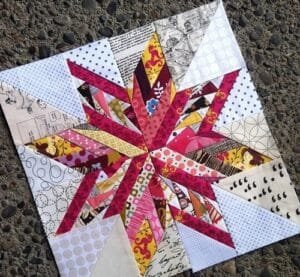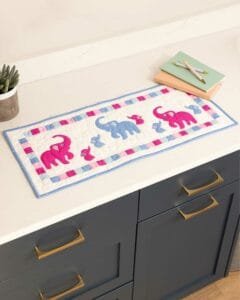The Wheel of Fortune quilt block pattern is a timeless design that combines traditional quilting techniques with a bold visual impact. Known for its circular motion effect created from precise piecing, this block has been cherished for generations and continues to inspire quilters today.
One of the unique qualities of the Wheel of Fortune quilt block is the sense of movement it creates within the quilt. Unlike simpler designs, this block requires careful attention to alignment and accuracy, which makes it a rewarding project for quilters who enjoy detail and precision.
Working with the Wheel of Fortune block allows quilters to dive into advanced techniques like curved piecing, careful trimming, and strategic fabric placement. The challenge lies in balancing color choices so that the spinning effect is highlighted while maintaining harmony across the quilt.

History and Origins of the Wheel of Fortune Block
The Wheel of Fortune block has deep roots in quilting traditions, dating back to the 19th century. Many early quiltmakers used this pattern as a way to showcase precision and artistry, often working with scraps of fabric from clothing or household textiles. The circular effect was admired because it added a sense of motion to otherwise static quilt layouts, symbolizing change, luck, and the turning of life’s wheel.
Over time, this pattern became a favorite among quilting communities across America and Europe. It was often included in sampler quilts, where multiple blocks of different designs were combined into one quilt to demonstrate skill and variety. The Wheel of Fortune quilt block pattern stood out because it required more technical skill than simple squares or triangles, making it a block that represented experience and mastery.
In modern times, the pattern has been adapted to suit both hand quilting and machine quilting. With advancements in fabric cutting tools, rotary cutters, and quilting software, quilters now have more ways than ever to create accurate pieces for the block. Despite these modern conveniences, the essence of the Wheel of Fortune block remains true to its origins—symbolizing craftsmanship, movement, and timeless beauty.
Many quilt historians believe that this block represents not only the artistry of quilting but also cultural symbolism. The circular movement in the design has been connected with cycles of fortune, destiny, and opportunity. This symbolic meaning is one reason why the Wheel of Fortune quilt block continues to capture the imagination of quilters across generations.
Today, quilting guilds and online communities celebrate this pattern by hosting challenges and workshops dedicated to mastering its construction. It is common to see quilters experimenting with bold fabric choices, blending tradition with modern flair. The versatility of the Wheel of Fortune quilt block pattern ensures its place as one of the most enduring and inspiring designs in the quilting world.
For beginners exploring this design, studying its history provides not only technical knowledge but also a deeper appreciation for its cultural impact. The block is not just a visual design—it is a link to quilting traditions that have been handed down through generations, making it a truly meaningful pattern to work on.
Techniques for Creating the Wheel of Fortune Block
To make a Wheel of Fortune quilt block pattern, precision is key. Quilters often start with templates or rotary cutting guides to ensure each piece is shaped correctly. Because of the circular motion effect, even a small inaccuracy in cutting or sewing can disrupt the flow of the design. This makes careful measuring and trimming essential steps in the process.
The construction usually begins with assembling the central star or rotating shapes that form the wheel. Depending on the variation, this may involve curved piecing, which can be challenging for those who are used to working only with straight seams. Practicing with smaller fabric scraps before committing to the main quilt pieces can help quilters feel more comfortable with these techniques.
Another essential aspect is fabric selection. The Wheel of Fortune block relies heavily on contrast to create the spinning motion effect. Choosing light and dark fabrics that complement each other enhances the illusion of movement. For a more modern look, quilters often experiment with bold prints and unexpected color palettes, while traditional quilters may prefer softer, muted tones.
Pressing techniques also play a significant role in achieving accuracy. Each seam must be carefully pressed to avoid bulk and ensure flatness, which allows the pieces to align properly. Some quilters prefer pressing seams open for this block, while others press to one side depending on the overall design.
Using modern quilting tools such as quarter-inch sewing feet, acrylic templates, and fabric stabilizers can significantly improve results. While traditional methods are still valuable, these tools make it easier to achieve the precision required for the Wheel of Fortune quilt block pattern.
Finally, patience is an essential technique. Because this block is more advanced than many others, it may take extra time and care to master. However, the satisfaction of completing a beautifully pieced Wheel of Fortune block makes the effort worthwhile, and many quilters consider it one of the highlights of their quilting journey.
Design Variations and Color Ideas
One of the most exciting aspects of working with the Wheel of Fortune quilt block is exploring the many design variations it offers. While the traditional pattern uses high contrast fabrics to emphasize the circular motion, modern quilters often experiment with softer gradients or even monochromatic palettes for a different effect.
Some variations simplify the pattern by reducing the number of pieces, making it more beginner-friendly while still maintaining the essence of the wheel design. Others add additional layers or borders, creating a more complex and dramatic block. The adaptability of the Wheel of Fortune quilt block pattern means that no two quilts look exactly alike, even when based on the same template.
Color theory plays a major role in this block. Pairing complementary colors can create a striking visual effect, while analogous colors provide a more subtle, flowing appearance. The use of solids versus prints also dramatically changes the outcome. A bold print may draw the eye to certain areas of the wheel, while solid fabrics highlight the geometric precision.
Some quilters enjoy creating themed versions of this block. For example, using festive colors for holidays, calming blues and greens for ocean-inspired quilts, or warm earth tones for a rustic look. This ability to personalize makes the Wheel of Fortune block appealing to both traditional and modern quilters.
Another variation involves scale. Enlarging the block can turn it into a stunning quilt centerpiece, while smaller blocks can be combined for intricate overall designs. This flexibility allows quilters to adapt the pattern to suit their project size and goals.
By experimenting with design choices, quilters can make the Wheel of Fortune quilt block pattern their own. The balance between tradition and innovation keeps this block fresh and exciting, ensuring it remains relevant for generations of quilters.
Tips for Beginners Working on the Wheel of Fortune Block
For those new to the Wheel of Fortune quilt block, the complexity can seem intimidating at first. However, with the right approach, even beginners can enjoy creating this beautiful design. The first step is to start small—focus on making a single block rather than an entire quilt. This allows you to practice the techniques without feeling overwhelmed.
It is also helpful to use high-quality fabric and tools. Crisp cotton fabric is easier to cut and sew accurately than stretchy or slippery materials. Investing in a rotary cutter, self-healing mat, and sharp quilting rulers will make the process much smoother and more enjoyable.
Beginners should also take the time to practice curved piecing, as this is one of the more challenging aspects of the Wheel of Fortune quilt block pattern. Practicing with scrap fabric before working on your main pieces can build confidence and reduce mistakes.
Another tip is to use pins or clips generously. Because of the block’s complexity, keeping fabric aligned during sewing is crucial. Marking points with a fabric pencil can also help ensure pieces line up correctly, especially in areas where multiple seams intersect.
Breaking the process into steps makes it more manageable. Instead of rushing, quilters should aim to complete one section at a time. This approach not only reduces errors but also helps build confidence as each part of the block comes together.
Lastly, beginners should embrace the learning process. Every mistake is an opportunity to improve, and even imperfect blocks can be beautiful. With patience and practice, creating the Wheel of Fortune quilt block becomes a rewarding experience that showcases growth and creativity.
FAQ about the Wheel of Fortune Quilt Block Pattern
What is the Wheel of Fortune quilt block pattern?
It is a traditional quilt design that creates the illusion of a spinning wheel using carefully pieced fabric shapes, often involving curved piecing and high contrast colors.
Is the Wheel of Fortune block suitable for beginners?
While it is considered more advanced due to curved seams and precise alignment, beginners can attempt it by starting with one block at a time and practicing techniques first.
Conclusion
The Wheel of Fortune quilt block pattern is a timeless design that combines tradition, symbolism, and artistry. Its circular motion effect makes it one of the most captivating patterns in quilting, offering endless opportunities for personalization through fabric, color, and scale. While it can be challenging, the reward of completing this block is immense, both in terms of skill development and creative satisfaction.
If you found this guide useful, I would love to hear your sincere opinion and suggestions. Your feedback helps keep the quilting tradition alive and evolving, just like the Wheel of Fortune block itself.



